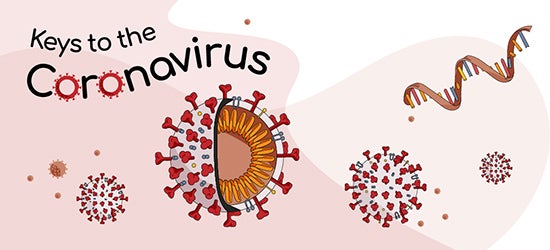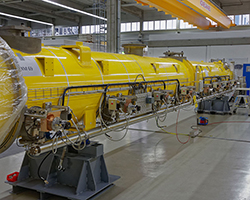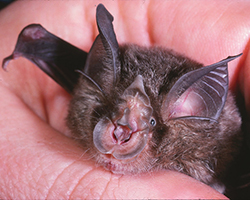
Illustrated by: Megan Joyce
Some people think the common cold starts with a sniffle. A dry tickle in the back of the throat. But a cold actually starts much earlier than that – it starts with a virus particle landing in your nose, lungs, mouth, or eye. That virus is tricky and manipulative. It confuses your cells into swallowing it up. Then, like a villain in an action movie, it takes control and starts ordering your cells around. Viruses copy themselves by using your own cell’s tools, energy, and resources. They turn your body into their personal virus factory! To protect ourselves from viruses, we need to understand how it is that they take over.

Brenda Hogue is a virologist at Arizona State University who studies a very problematic family of viruses, called coronaviruses (CoVs). Coronaviruses infect many kinds of animals, including humans. Four of the human coronaviruses are common, but they usually don’t cause much more than a mild cold. Three others cause more serious respiratory disease. The diseases are Severe Acute Respiratory Syndrome (SARS), Middle East Respiratory Syndrome (MERS), and the newest is Severe Acute Respiratory Syndrome 2 (SARS-CoV-2), the cause of Coronavirus Disease (COVID-19). The coronaviruses that cause these more severe diseases have led to epidemics that disrupt people’s lives, cause death, and affect humans in every part of the world, such as we’ve seen in the global COVID-19 pandemic.
Picturing Key Coronavirus Proteins
Hogue’s research focus is how coronaviruses are put together, and the virus proteins that are involved. Proteins are the building blocks of the virus’ body, and also help it replicate itself to make more viruses. But, studying coronavirus proteins is not as easy as magnifying viruses with a microscope. Viruses are very small – smaller than our cells, and smaller than other pathogens like bacteria. To study viruses, Hogue uses electron microscopes, as well one of the newest and largest devices available for researching tiny things: X-ray Free Electron Lasers (XFELs).
The XFEL looks like a series of tubes, and spans 3.4 kilometers in length (that’s 31 football fields laid end-to-end). Information about how X-rays are scattered by the virus is put into a computer. Then, teams use special calculations to make 3D pictures and movies of how virus proteins look and change shape. The information can then be used to figure out what chemicals would jam up the virus proteins, and stop them from working. This is one way to make antivirals, which are medicines that can help people recover from a virus.
Editing RNA to Understand Function

Hogue can also change the shape of proteins, to see how it affects the virus. Her lab does this by changing the coronavirus RNA genome. The RNA genome is found inside the virus, and is like a set of instructions that the virus uses to create proteins. Viruses also copy this RNA to make more virus particles. By editing the instructions given by the RNA, she can change the structure of the proteins that are made, and see how that affects the virus. She puts edited RNA into cells, the cells follow the instructions, and she sees if the viruses are made correctly or not. In this way, she can find which proteins are most important for making a functional virus.
Making Vaccines using Virus Proteins
Hogue’s deep understanding of coronavirus protein function helps her design vaccines. Vaccines train the body to recognize a virus, so the body can attack it before it makes the person sick. A coronavirus vaccine needs to have some kind of particle in it that looks a lot like the virus, but that does not cause any disease. Hogue’s approach is to use Virus-Like Particles (VLPs). Her VLPs look like a real coronavirus on the outside, but do not have the RNA or proteins that a real virus would use to make more viruses.
To make an effective coronavirus vaccine, one of the most important proteins to get right is the Spike protein. The Spike protein is on the outside of the virus, and is used by the virus to enter your cells. The Spike protein is also used by your immune system to recognize the virus. Hogue uses mammalian cells to make the VLPs, which means the Spike protein is made in much the same way as it would be in our own bodies. Hogue hopes this will make for a vaccine that gives a strong, protective immune response.

It took a lot of research by many different people, including Hogue, to figure out which exact proteins are needed to make good VLPs. Other people are working on vaccines that use inactivated or mutated viruses which still have the RNA genome in them. Her VLPs have no RNA genome, so they can never replicate. This makes them even safer to use in vaccines.
Hogue’s research not only gives us information that can help us fight known coronaviruses, but also new ones that may pop up in the future. There are many coronaviruses out there that only infect non-human animals now, but they could infect humans at some point. With a solid understanding of how their proteins work, we are better prepared to create medicines that combat new coronaviruses more quickly.
Additional images via Wikimedia Commons and Flickr. Cow and pig image by Danel Solabarrieta.
Read more about: Keys to the Coronavirus
Bibliographic details:
- Article: Keys to the Coronavirus
- Author(s): Ioulia Bespalova
- Publisher: Arizona State University School of Life Sciences Ask A Biologist
- Site name: ASU - Ask A Biologist
- Date published:
- Date accessed:
- Link: https://askabiologist.asu.edu/explore/keys-coronavirus
APA Style
Ioulia Bespalova. (). Keys to the Coronavirus. ASU - Ask A Biologist. Retrieved from https://askabiologist.asu.edu/explore/keys-coronavirus
Chicago Manual of Style
Ioulia Bespalova. "Keys to the Coronavirus". ASU - Ask A Biologist. . https://askabiologist.asu.edu/explore/keys-coronavirus
Ioulia Bespalova. "Keys to the Coronavirus". ASU - Ask A Biologist. . ASU - Ask A Biologist, Web. https://askabiologist.asu.edu/explore/keys-coronavirus
MLA 2017 Style

Be Part of
Ask A Biologist
By volunteering, or simply sending us feedback on the site. Scientists, teachers, writers, illustrators, and translators are all important to the program. If you are interested in helping with the website we have a Volunteers page to get the process started.
